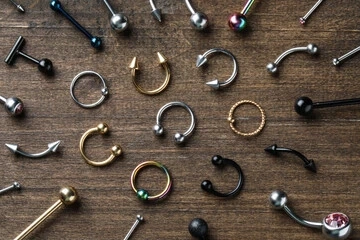Piercing jewellery is a vibrant expression of individuality and style, offering a multitude of options for self-expression. Whether you're a piercing enthusiast or considering your first piercing, understanding the diverse range of styles, materials, and care practices is essential. In this guide, we'll delve into the world of piercing jewellery, providing insights to help you make informed decisions and care for your piercings properly.
Introduction
Piercing jewellery serves both aesthetic and functional purposes, accentuating piercings while ensuring comfort and safety. From earlobes to eyebrows, noses to navels, piercings adorn various parts of the body, each demanding specific jewellery styles and materials.
Styles of Piercing Jewellery
Studs: Studs are among the most common piercing jewellery styles, characterised by their simplicity and versatility. Available in various designs, from classic balls to sparkling gems, studs suit a wide range of piercings, including earlobes, nostrils, and cartilage.
Rings: Rings offer a timeless elegance and come in various shapes, including captive bead rings, seamless rings, and segment rings. They are popular for earlobe, nostril, septum, and navel piercings, providing a bold and stylish look.
Barbells: Barbells feature a straight bar with a ball or decorative end on each side, making them ideal for tongue, nipple, and industrial piercings. They offer a sleek and minimalist aesthetic, perfect for those seeking understated elegance.
Hoops: Hoops, also known as circular barbells or horseshoes, are versatile jewellery pieces suitable for a wide range of piercings, including earlobes, nostrils, lips, and eyebrows. Available in various diameters and designs, hoops add a touch of sophistication to any piercing.
Dermal Anchors: Dermal anchors, or microdermal implants, are single-point piercings that sit flush against the skin, creating a unique and modern look. They can be adorned with gems, spikes, or other decorative ends, making them a popular choice for surface piercings.
Materials Used in Piercing Jewellery
Choosing the right material for your piercing jewellery is crucial for both comfort and safety. Here are some commonly used materials:
Surgical Stainless Steel: Surgical stainless steel is a popular choice for piercing jewellery due to its durability, affordability, and hypoallergenic properties. It is suitable for most piercings and is easy to clean and maintain.
Titanium: Titanium is another excellent choice for piercing jewellery, known for its lightweight, corrosion resistance, and biocompatibility. It is an ideal option for individuals with metal allergies or sensitivities.
Niobium: Niobium is a hypoallergenic metal similar to titanium, making it suitable for those with sensitive skin. It is often used for piercings in need of longer-term wear, such as stretched lobes or surface piercings.
Gold: Gold jewellery adds a touch of luxury to piercings and is available in various karats, including 14k and 18k. However, it's essential to ensure that gold jewellery is nickel-free to prevent allergic reactions.
Bioflex: Bioflex, also known as biocompatible plastic, is a flexible and hypoallergenic material suitable for initial piercings and sensitive areas. It is comfortable to wear and reduces the risk of irritation or infection.
Organic Materials: Organic materials such as wood, bone, and horn offer a unique and natural aesthetic for piercing jewellery. However, they require extra care to prevent warping, cracking, or bacterial growth.
Caring for Your Piercing Jewellery
Proper care is essential to ensure the longevity of your piercing jewellery and maintain healthy piercings. Here are some tips for caring for your piercing jewellery:
Cleanse Regularly: Cleanse your piercing jewellery and the surrounding area with saline solution or a gentle soap to remove dirt, bacteria, and debris. Avoid using alcohol or hydrogen peroxide, as they can irritate the skin and delay healing.
Avoid Harsh Chemicals: Avoid exposing your piercing jewellery to harsh chemicals such as perfumes, lotions, and cleaning products, as they can cause irritation or allergic reactions.
Handle with Care: Handle your piercing jewellery with clean hands to prevent introducing bacteria or causing trauma to the piercing site. Avoid twisting or fiddling with the jewellery, as this can disrupt the healing process.
Rotate Occasionally: For piercings with threaded jewellery, such as studs or barbells, gently rotate the jewellery during cleaning to prevent it from becoming stuck or embedded.
Seek Professional Advice: If you experience any signs of infection, irritation, or discomfort, seek advice from a professional piercer or healthcare provider. They can assess the situation and provide guidance on proper care and treatment.
Conclusion
Piercing jewellery offers a world of possibilities for self-expression and style, with an array of styles, materials, and care practices to suit every individual. By understanding the diverse options available and following proper care guidelines, you can enjoy your piercings safely and stylishly for years to come. Remember to choose high-quality jewellery made from hypoallergenic materials, cleanse your piercings regularly, and seek professional advice if needed. With the right knowledge and care, your piercing journey can be a rewarding and beautiful experience.



